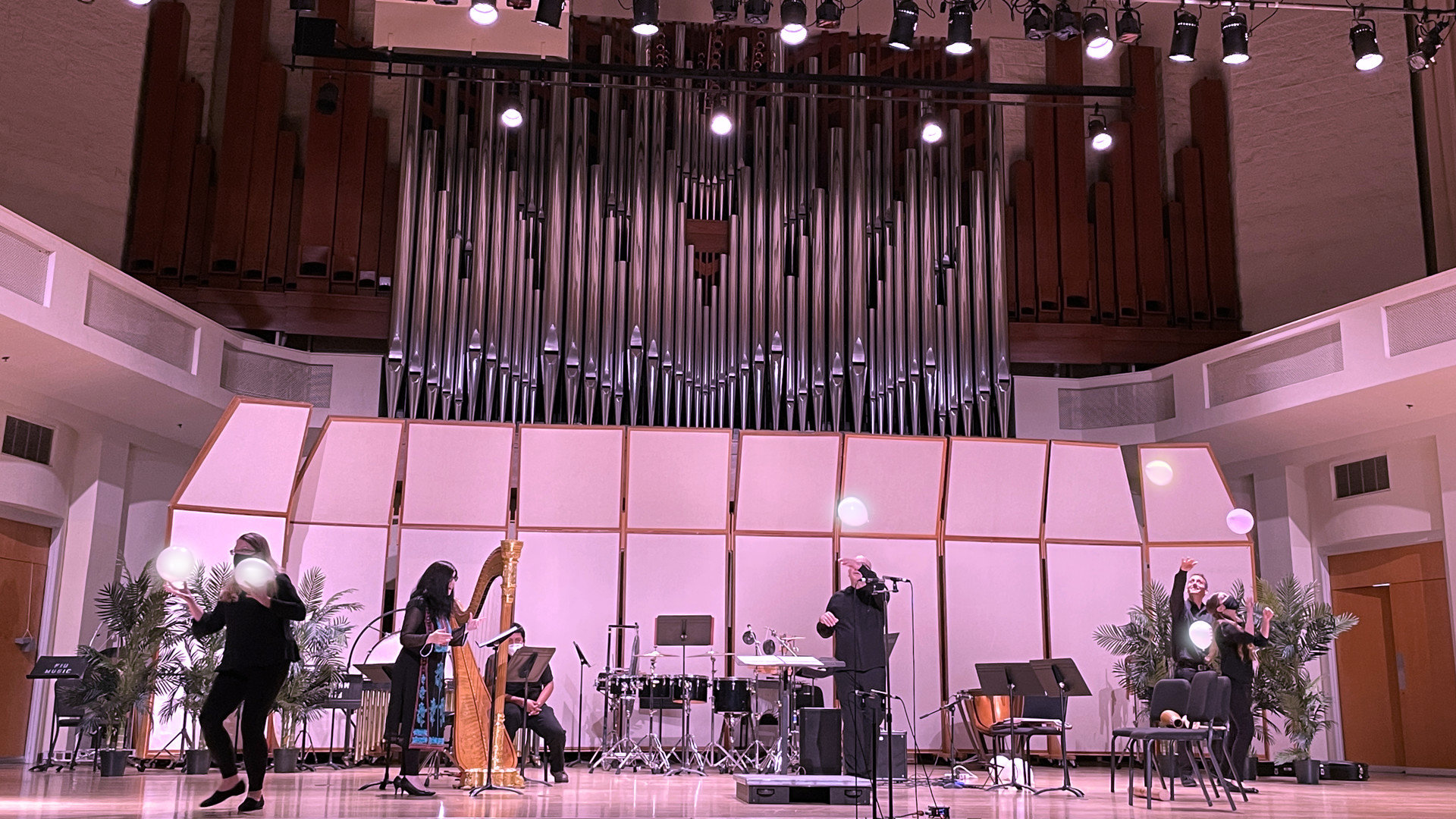
New and Experimental Music,
Art & Technolgy

New and Experimental Music,
Art & Technolgy

Miami’s new music audience just scored another treat; The Last Hundred Ensemble performed their inaugural concert on June 19 at The Herbert & Nicole Wertheim Performing Arts Center at FIU.
As their name suggests, The Last Hundred performs a repertoire composed over the last century. For this occasion, Juan Trigos, the ensemble’s artistic director and conductor, chose geographically and historically diverse music by Igor Stravinsky, Ricardo Zohn-Muldoon, Federico Bonacossa, and Catalina von Wrangell.
With two Miami-based composers, von Wrangell and Bonacossa, TLH anchored their base in Miami with the ambition of establishing an international network of collaborations in the future.
Von Wrangell’s piece Observing Time-Tiempo-Zeit for flute, violin, harp, guitar, and percussion is the first work commissioned by TLH Ensemble. In its title, the composer suggests a multilingual postmodern concept of wordplay through different perceptions of time. Observing Time-Tiempo-Zeit is an intimate reflection of her ramble through the art forms of composition and poetry, as well as different countries (Columbia, Spain, Germany, the USA) and identities.
Her piece’s short motifs bounced from one side of the stage to another, gradually taking listeners’ ears off to a lyrical and often distant world. Performers’ personal interpretations, musical imagination, and sensibilities delivered the poetic verses in the score. Misha Vitenson gently underlined these emotional states with violin drones accompanied by Laura Sherman’s unobtrusive yet warm passages. They led the audience to the lowercase aesthetic and von Wrangell’s music essence, delivered through flutist Dmytro Gnativ’s breath without flute sounds, and Karli Viña’s vibraphone resonance filled the ether at Wertheim.
The second piece of the repertoire was Florida’s premiere of Flores Del Viento for soprano, flute, violin, and percussion by Mexican composer Ricardo Zohn-Muldoon. He contoured this six-movement suite in Danzas, colored by Latin-American/African percussion instrumental timbres, and set to motion with claves (rhythmical patterns).
Danzas engaged the performers in a unique and entertaining dance-like performance; they often instantly switched multiple percussions, including their primary instruments. With such orchestration, the TLH chamber ensemble reverberated much like an unusual chamber orchestra. The performers led the audience from Invocación and the sunrise (Danza del Alba), through Danza del Sueño Ligero, and the gloomy night in the rainy tropical forest in Danza Nocturna next to the river of El Rio Pasa, to the sunset (Danza del Fuego). The playful journey ended with a creaking violin coo in a death lullaby (Arrullo de Muerte).
Trigos impeccably led the ensemble in sharp and precise entrances. Similarly, Daniela D’Ingiullo skillfully fulfilled multiple roles on the stage as a percussionist, singer, and vocal artist, proving her inclination toward interpreting a contemporary classical music repertoire.
In lyrical dialogs, D’Ingiullo and Vitenson subtly brought wide ranges of expressiveness in this piece. The contemplative culmination happened between D’Ingiullo and Viña on the vibraphone. Other performers supported by blending in the overall atmosphere, coming to a soft summation of one (musical) life.
After the intermission, TLH delivered Igor Stravinsky’s Four Russian Songs (The Drake, A Russian spiritual, Geese and Swans, and Tilim-born), written in, for that time, an unusual ensemble of soprano, flute, harp, and guitar. Sherman’s unbreakable yet warm beat on harp and Federico Bonacossa’s playful guitar rhythms provided a foundation for Gnativ’s resonant woodwind melodies and D’Ingiullo’s excellent pronunciation of old Russian tunes, yet often overpowered by instruments.
With a hundred-year leap, the concert continued with Omaggio a Marinetti, which we may assume Bonacossa dedicated to the first Italian futurist. Bonacossa adapted the five-movement piece for soprano, electric guitar, harp, and percussion for this occasion. From the first movement, Rose/Viole, Viña dominated in the background, virtuously dancing in transitions between multiple instruments and different mallets. Next, in Macchina Lirica, it was clear that the composer blended the soprano as part of the ensemble to perform various singing, narration, and performance roles. However, with the amplified guitar sound and vocalist position turned to performers rather than the audience, the vocal melody was often overwhelmed by other resonances. Finally, in the third movement, Pausa, the audience experienced music theatre with recitativo bringing fantasia both in words and through musicians’ innocent play with balloons. Contrasting, Aereopoebia shifted from an improvised play to a strict minimalist counterpoint while Zumb/Grang/Zzan/Tummm concluded the piece with mystical timpani and voice.
When we think about new music, we often encompass the 21st century and the entirety of the 20th-century’s musical output. We tend to consider all the innovations this music brings and observe it in the trajectory of similar works in music history. We tend to pull out the treads we need to knit our unique aural world of meanings by reflecting on historical familiarities. Likewise, The Last Hundred offers its contribution to a sophisticated interdisciplinary contemplation about music histories. Miami now has another ensemble to treasure and initiate new music works in the community and enrich the local scene with them.